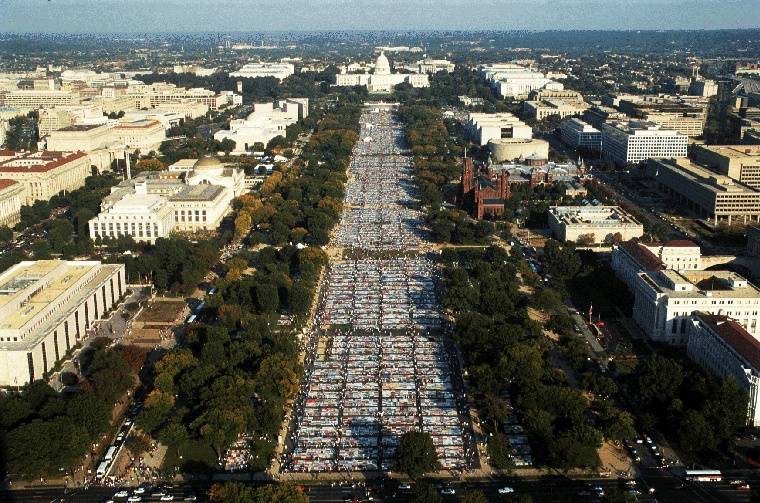The Castro Into the 90s
Historical Essay
by Erik Scudder, 1997
The NAMES Project/AIDS QUILT: The outpouring of sorrow for the tens of thousands of AIDS victims found wide expression in the making and displaying of hand-made quilt panels, which ultimately filled the mall in Washington D.C. in 1995.
Photo: Rick Gerharter
After the political and social gains that were made in 70s, the Castro district faced a new enemy that emerged in 1980. It was a mysterious disease dubbed "Gay Cancer" and later, AIDS. It was killing gay men and as the death tolls continued to mount, the Castro began to change. The party was over. But the Band Played On. Bathhouses were shut down shortly thereafter to curb the spread of AIDS and the gay community went into action to educate not only its members but the world at large about AIDS and how to help those afflicted with it.
Groups like Aids Coalition To Unleash Power (ACT UP) and Queer Nation came into being. Many of their demonstrations shocked the world into knowing and realizing that AIDS was not exclusively a gay man's disease and that quick government action and research was needed to find a cure. The Reagan Administration dragged its feet and even refused to acknowledge the presence of AIDS until 1987. Ronald Reagan never even mentioned the word "AIDS" during his entire time as President. Hateful epithets and anti-gay smear campaigns emerged from the Christian Right led by Jerry Falwell, Fred Phelps, Pat Robertson, Lou Sheldon and Jimmy Swaggart.
Still, the Castro District fought on and supported its own community. One of the ways this was done was by sewing panels to form a huge quilt called The AIDS Memorial Quilt. Each panel was sewn by a friend of a person who died of AIDS. The panel symbolized the person's life interests and became a unique way of remembering them. The Names Project at 2362 Market Street headquarters this unique memorial. Another was the multitude of support agencies that sprang up. Shanti, Project Open Hand, Stop AIDS Project and many others formed to support their community in ways the government could not or would not.
But the Castro did change. New businesses replaced old, and new people moved into the Castro. Harvey Milk's camera store at 575 Castro Street is now home to a cosmetic store called Skin Zone. The Elephant Walk Bar (500 Castro Street--famous for the White Night Riots) closed and re-opened as a restaurant called Harvey's. Once an enclave almost exclusively for gay men, babystrollers were now being seen. Straight couples began to see why the Castro was so popular: it was a quiet, charming area filled with Victorian and Edwardian architecture and it was the most accessible and convenient place to live in San Francisco. The Muni Metro underground station at Castro & Market Street provided easy access to downtown workers. Geographically, it was perfect.
The NAMES Project/AIDS Quilt in Washington DC, 1995
Photo: Rick Gerharter


